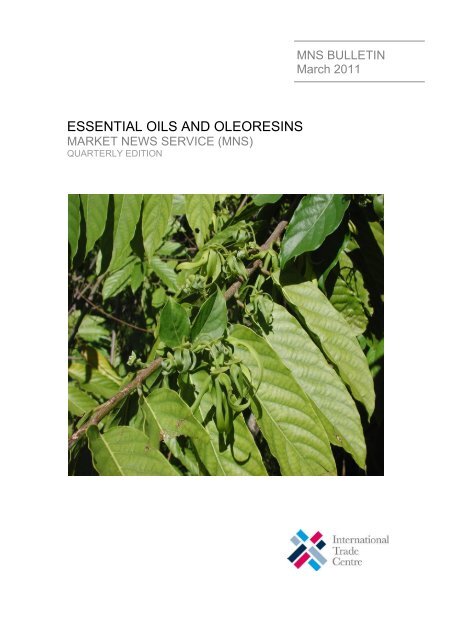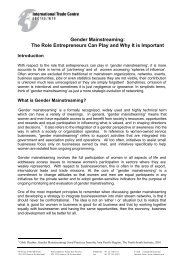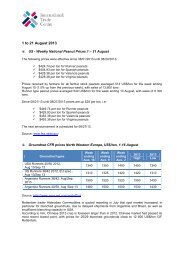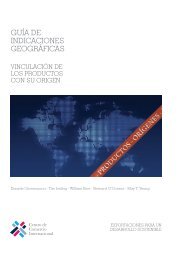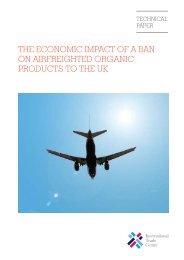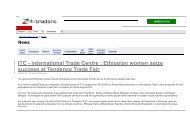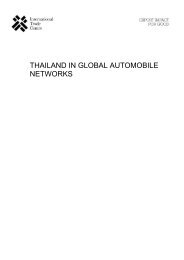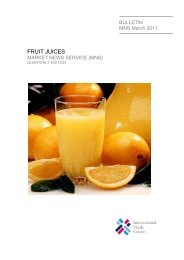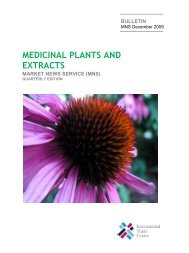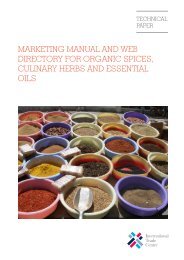Market News Service - International Trade Centre
Market News Service - International Trade Centre
Market News Service - International Trade Centre
Create successful ePaper yourself
Turn your PDF publications into a flip-book with our unique Google optimized e-Paper software.
ESSENTIAL OILS AND OLEORESINS<br />
MARKET NEWS SERVICE (MNS)<br />
QUARTERLY EDITION<br />
MNS BULLETIN<br />
March 2011
Disclaimer<br />
This report has been prepared without formal editing, as a service to exporters and industries in<br />
developing countries by the <strong>Market</strong> <strong>News</strong> <strong>Service</strong> (MNS), Division of Product and <strong>Market</strong><br />
Development, <strong>International</strong> <strong>Trade</strong> <strong>Centre</strong> UNCTAD/WTO.<br />
No part of this report may be reproduced, stored in a retrieval system or transmitted in any form<br />
or by any means, without prior permission in writing from the <strong>International</strong> <strong>Trade</strong> <strong>Centre</strong>.<br />
The mention of specific companies or of certain commercial products and brand names does not<br />
imply that they are endorsed or recommended by ITC in preference to others of a similar nature<br />
that are not mentioned.<br />
The designations employed and the presentation of material on the map do not imply the<br />
expression of any opinion whatsoever on the part of the <strong>International</strong> <strong>Trade</strong> <strong>Centre</strong> concerning<br />
the legal status of any Country, territory, city or area or of its authorities, or concerning the<br />
delimitation of its frontiers or boundaries.<br />
<strong>Market</strong> <strong>News</strong> <strong>Service</strong><br />
Essential Oil and Oleoresins
<strong>Market</strong> <strong>News</strong> <strong>Service</strong><br />
Essential Oils & Oleoresins, EU and US <strong>Market</strong> Report<br />
Report prepared for ITC‘s <strong>Market</strong> <strong>News</strong> <strong>Service</strong> by:<br />
EU markets: Mr. Steve Caiger (steve.caiger@highvaluehorticulture.com)<br />
US markets: Ms. Kerry Hughes (kerry@ethnopharm.com)<br />
Issue Number 1, March 2011<br />
The <strong>Market</strong> <strong>News</strong> <strong>Service</strong> of the <strong>International</strong> <strong>Trade</strong> <strong>Centre</strong> UNCTAD/WTO (ITC) provides timely<br />
and detailed price and market information on selected primary and semi-processed products of<br />
particular interest to developing countries and economies in transition. Regular access to such<br />
information is vital to companies deciding when and where they should sell or buy products on<br />
international markets. MNS thus aims to serve as a market intelligence tool, to enable developing<br />
countries realize their full income potential through global trade expansion. MNS does not act as<br />
a broker and is exclusively an information service with the objective of improving market<br />
transparency and encouraging price and quality competition for the benefit of all market players.<br />
MNS‘ team of product specialists draws its information from a network of correspondents in many<br />
countries worldwide, collecting up-to-date data on wholesale prices paid for specific products,<br />
supply and demand trends, and economic, climatic and legislative information that can affect the<br />
short-term market situation of particular products. MNS' information providers include major<br />
importers, exporters, manufacturers, wholesalers, and governmental organizations. We<br />
continuously encourage and welcome new sources of information. Should you be interested in<br />
becoming an information provider and contributing to MNS' efforts to improve market<br />
transparency and facilitate trade, please contact us at mns@intracen.org.<br />
For more information about the report and the <strong>Market</strong> <strong>News</strong> <strong>Service</strong>, please contact<br />
mns@intracen.org or visit our website on http://www.intracen.org/market-news<br />
No part of these reports may be reproduced, stored in a retrieval system, or transmitted in<br />
any form or by any means without the prior permission of the MNS/ITC Geneva.<br />
Copyright © MNS/ITC 2011. All rights reserved<br />
<strong>Market</strong> <strong>News</strong> <strong>Service</strong><br />
Essential Oil and Oleoresins<br />
3
INDEX<br />
MARKET CONDITIONS 5<br />
EU <strong>Market</strong>s 5<br />
US <strong>Market</strong> 5<br />
FUEL SUSTAINABILITY 6<br />
Fuel costs and carbon footprint 6<br />
SPECIAL FOCUS: 7<br />
Flavour & Fragrance Industry Sales, with a Focus on Industry Leaders 7<br />
Mainstream Industry Trends 11<br />
Supplying the Top Ten 12<br />
SUPPLIERS OF EQUIPMENT 13<br />
Africa 13<br />
PRICE INFORMATION 16<br />
US <strong>Market</strong>s 16<br />
EU <strong>Market</strong>s 19<br />
NEWS & UPDATES 22<br />
Cinnamon active label extends peach shelf life, maintains sensory qualities 22<br />
Global industry looks at India as a future hub for Fragrances and Flavours 23<br />
Study notes HPP effectiveness in reducing Listeria risk in yoghurt 24<br />
Using wastewater to enhance mint production 25<br />
Mentha oil remains up in futures trade 26<br />
EVENTS CALENDAR 27<br />
<strong>Market</strong> <strong>News</strong> <strong>Service</strong><br />
Essential Oil and Oleoresins
<strong>Market</strong> Conditions<br />
EU <strong>Market</strong>s<br />
The market has not been badly disturbed by<br />
the political upheavals in North Africa,<br />
although prolonged problems in Egypt would<br />
have had a serious impact given the range of<br />
products for which it is an important origin.<br />
Provided the situation there remains basically<br />
stable – in terms of the day-to-day economy<br />
functioning – there should not be any major<br />
impact on product prices. Tunisia is a<br />
commercial producer of a narrow range of<br />
essential oils (neroli, rosemary) but it is not a<br />
dominant origin, so the continuing disruption<br />
there should not affect the market unduly.<br />
Libya and Syria do not have significant<br />
essential oil production, and Morocco, the<br />
other major producer in North Africa, has not<br />
been involved in the turmoil.<br />
Prices of almost all essential oils remain firm,<br />
driven by 2 basic factors:<br />
The flavours and fragrances market<br />
continues to grow, and<br />
US <strong>Market</strong><br />
According to a Malagasy producer, there was<br />
explosion of geranium and ravintsara demand<br />
in the first quarter of the year which continues<br />
to grow. Geranium oil is being sold at 200 euro<br />
FOB now. They have also noticed the rise in<br />
demand of the vegetable oil of calophyllum<br />
inophyllum(also called forah in Madagascar).<br />
In Guatemala the harvesting season of<br />
cardamom has finished. The total production<br />
expected from Sept-2010 till August-2011<br />
seems to be 10-15% more in comparison with<br />
last season. Prices are at high levels, which<br />
are reported to likely stay at the same levels<br />
until next season which starts in October.<br />
During recent years the weather conditions<br />
have been the most important condition<br />
regarding production volumes in Guatemala.<br />
US importers of essential oils are reporting<br />
strong demands for American peppermint oil,<br />
resulting in firm prices, which may potentially<br />
increase in the next few months. Spearmint oil<br />
is also reported to have firm pricing. Indian<br />
suppliers continue to explain the lack of<br />
<strong>Market</strong> <strong>News</strong> <strong>Service</strong><br />
Essential Oil and Oleoresins<br />
Updates<br />
Fuel costs, which represent a major part<br />
of the costs of the production of all<br />
products, are very high and likely to<br />
remain so.<br />
An additional factor is the range of crop<br />
options that farmers have these days,<br />
particularly short term fresh food crops. This<br />
has resulted in farmers being able to turn<br />
away from ‗traditional‘ crops when prices are<br />
poor. They are no longer tied in to production<br />
of a particular crop but have a broad range of<br />
options to choose from. The consequence of<br />
this is that many have permanently<br />
abandoned the traditional cultivation of<br />
essential oils, while others might possibly drop<br />
the crop when returns are poor and<br />
alternatives offer better returns. These<br />
changes are driving the industry towards<br />
‗sustainable‘ pricing as a necessary strategy to<br />
avoid the continuing uncertainty over supply<br />
and price spikes from shortages.<br />
supplies and high prices of essential oils from<br />
India due to adverse weather conditions,<br />
inflation, and the strengthening of the Indian<br />
currency against the US dollar. Likewise, in<br />
Indonesia, shippers are reporting that even<br />
though it was still rainy (in February when this<br />
was reported), the situation has improved with<br />
both prices and with available stock, possibly<br />
due to anticipation of the end of the rainy<br />
season.<br />
The recent flooding in Australia has reportedly<br />
impacted the tea tree oil distillation this year,<br />
with estimates that the 2011 production may<br />
be 30% less than last year. Increases in the<br />
currently quoted prices (approx. US$40/kg) for<br />
tea tree oil are foreseen.<br />
In Paraguay the Petitgrain distillation season<br />
which should have begun by now, but has<br />
been delayed by about two months; therefore,<br />
production is limited and producers are now<br />
busy with other products. Oil Guaiacwood has<br />
been taken off the CITES list early this year,<br />
and therefore is being exported once again.<br />
5
Fuel Sustainability<br />
Fuel costs and carbon footprint<br />
Distillation operations using fuel – typically<br />
diesel or heavy fuel oil – have seen major<br />
price rises over the last few years, and the<br />
signs are that prices are going to remain high,<br />
and that further upheavals in the Middle East<br />
area have the potential to send them higher<br />
still. Even without any consideration of<br />
political disturbances, it is clear that global<br />
demand has risen, and is continuing to rise,<br />
and this is likely to keep prices where they are,<br />
or to push them higher still. Fuel costs are a<br />
major in distillation costs, and enterprises<br />
have to find ways to reduce usage, and/or to<br />
change to lower priced fuels. New boilers and<br />
burners can offer significant efficiency savings<br />
over old equipment, but important and cost<br />
effective benefits can be obtained by<br />
optimising insulation to minimise heat loss,<br />
putting in heat recovery systems to make use<br />
of waste heat, using simple solar collectors to<br />
pre-heat water etc.<br />
As well as trying to minimise fuel usage,<br />
enterprises need to consider their carbon<br />
footprint, and start to work on strategies to at<br />
least minimise it, and then to start off-setting it.<br />
This is starting to become an important factor<br />
in the market, and will become increasingly so.<br />
It is much better to be a leader in offering<br />
carbon neutral product, than to be driven to do<br />
it at the end and not have the time to identify<br />
and plan for the best way to achieve it. Fuel<br />
used is likely to be the major source of carbon<br />
usage, although if crops are grown under<br />
intensive systems, with irrigation and high<br />
fertilizer inputs, crop production itself may<br />
have a significant carbon footprint, which will<br />
also need to be considered. Minimising fuel<br />
used in distillation will reduce the carbon<br />
footprint of the enterprise. After that, the<br />
strategy changes to off-setting – either through<br />
the purchase of carbon credits, or the<br />
generation of credits (such as through<br />
registered tree planting schemes). The costs<br />
of this are not great, but the beneficial impact<br />
<strong>Market</strong> <strong>News</strong> <strong>Service</strong><br />
Essential Oil and Oleoresins<br />
– both to the environment and the business -<br />
can be. As an indication, for each 10,000<br />
litres of diesel used in a boiler, around 27<br />
tonnes of CO2 equivalent (tCO2e) is released<br />
– so that 27 credits are required to offset it.<br />
Prices of credits vary depending on whether<br />
they come from voluntary schemes or formal<br />
CDM credit schemes, but at around<br />
US$10/credit, the total offset cost would be<br />
US$270 for each 10,000 litres used.<br />
Alternatively, tree planting schemes could be<br />
started, to generate credits. Schemes have to<br />
run for a certain time – typically 15 years, but it<br />
can be shorter – so that they may not be<br />
suitable for fuel wood schemes. In the<br />
voluntary sector RED credits (for avoided<br />
deforestation) can be generated, and<br />
boundary tree planting schemes (around<br />
landholdings) are also accepted. Once the<br />
carbon credit system is understood – and<br />
frequently there are locally based<br />
organisations that have made it their business<br />
to understand the system, in East Africa for<br />
example the Uganda Carbon Bureau is a very<br />
good first point of contact – an appraisal of the<br />
business can identify a range of ways through<br />
which carbon usage can be minimised and<br />
credits generated to move towards offsetting<br />
the carbon footprint.<br />
Enterprises that run wood fired distillation<br />
operations – either an open fire or wood fired<br />
steam boilers – also have to consider fuel<br />
usage, as the same principles apply as for<br />
enterprises using diesel. Wood is becoming<br />
scarce, prices are rising, and burning wood is<br />
generating a carbon footprint.<br />
Uganda Carbon Bureau<br />
Plot 47 Lubowa Estate<br />
PO Box 70480<br />
Kampala. Uganda<br />
Tel/fax: +256 (414) 200988<br />
Contact: Bill Farmer, Chairman<br />
billfarmer@ugandacarbon.org
Special Focus<br />
Flavour & Fragrance Industry Sales, with a Focus on<br />
Industry Leaders<br />
The flavour and fragrance Industry is<br />
dominated by a few large corporations that<br />
control the majority of the market share<br />
while the more numerous small Flavour<br />
and fragrance companies continue to lose<br />
market share. Last year was no different<br />
in this trend, as 2010 saw some of the<br />
largest year-to-year gains, with an<br />
estimated total market growth of<br />
approximately 10% in US$ 1 . The small<br />
flavour and fragrance companies, on the<br />
other hand, were reported to lose market<br />
share on the order of about 4.5% in US$.<br />
Who are the Top 10 Industry Leaders?<br />
1. Givaudan SA<br />
Corporate Headquarters:<br />
5, Chemin de la Parfumerie<br />
Vernier, - 1214 Switzerland<br />
http://www.givaudan.com/<br />
Givaudan is the top Flavour & fragrance<br />
company in the world. They claim their<br />
success has to do with their innovation,<br />
and they have a focus on building<br />
partnerships with clients. They list their<br />
mid-term objectives based on assumed<br />
market grown of 2-3% as being a 4.5-5.5%<br />
organic sales growth, the best in class<br />
EBITDA, 14-16% free cash flow of sales<br />
by 2015, and above 60% free cash flow<br />
return. The key ‗pillars‘ of their five-year<br />
strategy are reported to be developing<br />
markets, research and development,<br />
health and wellness, sustainable sourcing<br />
of raw materials, and targeted customers<br />
and segments.<br />
As reported by Leffingwell & Associates: In<br />
2010, Givaudan Group sales totalled CHF<br />
4,239 million, an increase of 8.9% in local<br />
currencies and 7.1% in Swiss francs<br />
compared to the previous year. Sales of<br />
the Fragrance Division were CHF 1,988<br />
million, an increase of 10.5% in local<br />
currencies and 9.0% in Swiss francs.<br />
Sales of the Flavour Division were CHF<br />
1 Leffingwell & Associates<br />
<strong>Market</strong> <strong>News</strong> <strong>Service</strong><br />
Essential Oil and Oleoresins<br />
2,251 million, an increase of 7.5% in local<br />
currencies and 5.4% in Swiss francs<br />
compared to the previous year.<br />
2. Firmenich SA<br />
Corporate Headquarters:<br />
Rue de la Bergère 7<br />
P.O. Box 148<br />
Meyrin 2 CH-1217 Switzerland<br />
Firmenich is the largest privately owned<br />
flavour and fragrance company in the<br />
world. It was founded in 1895 and early on<br />
became known for signature fragrance<br />
chemicals, such as Dianthine® and<br />
Iralia®, which are still present on the<br />
market today. Their strongest growth<br />
markets today are geographically in<br />
emerging market, with a new affiliate in<br />
Dubai opened this year to serve the Gulf<br />
region, a new state-of-the art perfume and<br />
Flavour development center in Brazil to<br />
service Latin America, and a new Perfume<br />
ingredients plan in India to support their<br />
global business.<br />
As reported by Leffingwell & Associates:<br />
For the financial year ended June 30,<br />
2010, Firmenich posted record sales of<br />
CHF 2873 million, an increase of 12.1% in<br />
local currencies and 8.7% in Swiss Francs,<br />
regaining its position as growth leader in<br />
the fragrance and Flavour industry. This<br />
performance was driven by double-digit<br />
growth in Perfumery and Flavour<br />
segments, with a particularly strong<br />
rebound in Fine Fragrance during the<br />
second half of the year. The perfume and<br />
Flavour ingredients business followed the<br />
trend, recording a healthy high single-digit<br />
growth performance. Leffingwell estimates<br />
that Firmenich increased market share by<br />
about 1.7% in the period.<br />
3. IFF<br />
Corporate Headquarters:<br />
521 West 57th Street<br />
New York, NY 10019 USA<br />
7
IFF‘s vision is to create unique scent &<br />
taste experiences people love. They say<br />
they do this through their commitment to<br />
customers, people and innovation.<br />
Since 1833 they have been in the Flavour<br />
and fragrance business, originally started<br />
by a miller and a druggist with a focus on<br />
the production of essential oils, especially<br />
sandalwood oil and clove. In 2011, IFF<br />
has announced plans to invest over $100<br />
million in Greater Asia over the next few<br />
years to be allocated to two new state-ofthe-art<br />
manufacturing facilities located in<br />
Guangzhou, China and Singapore. IFF‘s<br />
2010 net sales were $2.6 billion and had<br />
operations in 33 countries.<br />
4. Symrise<br />
Corporate Headquarters:<br />
Muehlenfeldstraße<br />
Holzminden, 37603 Germany<br />
In the medium term Symrise is striving to<br />
become one of the three leading<br />
manufacturer in the Flavour and fragrance<br />
industry. In order to do this they plan to<br />
grow globally with defined customers,<br />
growing in the emerging markets of Asia,<br />
South America, the Middle East and<br />
Africa. They plan to strategically<br />
strengthen themselves through<br />
acquisitions.<br />
As reported by Leffingwell & Associates:<br />
Symrise increased sales in 2010 by 15.4<br />
% to € 1.571.9 million (+11% in local<br />
currency) and exceeded its target to<br />
achieve sales growth of at least 8 %.<br />
Scent & Care sales increased 17.9% to €<br />
804.5 million while Flavour & Nutrition<br />
sales increased 12.9% to € 804.5 million.<br />
5. Takasago<br />
Corporate Headquarters:<br />
Nissey Aroma Square 17F<br />
5-37-1, Kamata<br />
Ohta-Ku, - 144-8721 Japan<br />
Founded in Japan in 1920, Takasago has<br />
developed Flavours and fragrances for<br />
over 80 years, and has a focus on the<br />
Asian region. Takasago maintains<br />
operations in 24 countries and through this<br />
network strive to deliver individual market<br />
solutions. Takasago also has pursued<br />
<strong>Market</strong> <strong>News</strong> <strong>Service</strong><br />
Essential Oil and Oleoresins<br />
pharmaceutical intermediaries, functional<br />
materials and other fine chemicals, with<br />
asymmetric synthesis being used as a key<br />
technology.<br />
As reported by Leffingwell & Associates:<br />
Sales for the half fiscal year ending<br />
September 30, 2010 were ¥ 60,547<br />
million, up 2.9% from the prior year while<br />
net income increased 85.1% to ¥ 3,325<br />
million.<br />
6. Mane SA<br />
Corporate Headquarters:<br />
620 Route de Grasse<br />
06620 Le Bar Sur Loup, France<br />
Founded in 1871, Mane began as a<br />
company supplying and producing fragrant<br />
materials from regional flowers and plants.<br />
It grew internationally between 1916 and<br />
1958, and then in 1959 diversified into the<br />
Flavourings for the food industry.<br />
Mane reportedly consolidates their<br />
activities with the promotion of human<br />
resources, the quality assurance of their<br />
products, and with their environmental<br />
protection management system.<br />
As reported by Leffingwell & Associates:<br />
Mane achieved a consolidated turnover of<br />
480.1 million Euros in 2010, up 26.7%<br />
from 376.2 million Euros in 2009 (personal<br />
communication, Leffingwell & Associates).<br />
7. Sensient Flavours<br />
Corporate Headquarters:<br />
777 East Wisconsin Avenue<br />
Milwaukee, WI 53202-5304 USA<br />
Sensient Technologies is not only one of<br />
the largest Flavour and fragrance<br />
companies in the world, but they also<br />
supply colours that are used in a diversity<br />
of products, from food and beverages,<br />
pharmaceuticals, cosmetics, home and<br />
personal care products, specialty printing<br />
and imaging products, as well as computer<br />
imaging and industrial colours.<br />
As reported by Leffingwell & Associates:<br />
The Flavours & Fragrances Group<br />
reported full year 2010 sales of $809.1<br />
million, an increase of 4.7% vs. 2009.<br />
Operating income for the same period<br />
declined 2.0%. For the 4th Qtr, F&F sales
were $206.1 million, up 5.2% while<br />
operating income declined 0.5%. As these<br />
figures include dehydrated products such<br />
as dehydrated vegetables that are about<br />
28% of sales, we estimate that the sales of<br />
conventional Flavours & fragrances in<br />
2010 were about $582.6 million.<br />
8. T. Hasegawa<br />
Corporate Headquarters:<br />
4-4-14, Nihonbashi Hon-cho,<br />
Chuo-ku, Tokyo 103-8431<br />
Since 1903, T. Hasegawa has focused on<br />
quality and service. Today they are<br />
second in the Japanese market, and<br />
eighth in the global market. Operations<br />
are focused in the US, Japan, Singapore<br />
and China.<br />
As reported by Leffingwell & Associates:<br />
For the full year ending September 30,<br />
2010 consolidated net sales were ¥<br />
45,167 million, up 4.4%. For the same<br />
period, net income increased 58.5% to ¥<br />
2,840 million.<br />
9. Robertet SA<br />
Corporate Headquarters:<br />
37, Avenue Sidi Brahim<br />
BP 52100<br />
06130 Grasse Cedex, France<br />
Robertet describes itself as being above<br />
all a natural aromatic products company.<br />
Their natural raw materials are produced<br />
in one of their four factories, located in<br />
France, Turkey, South Africa or Belgium.<br />
Robertet is a family business that is<br />
<strong>Market</strong> <strong>News</strong> <strong>Service</strong><br />
Essential Oil and Oleoresins<br />
quoted on the Paris stock exchange since<br />
1984, and it prides itself on family<br />
traditions that live on in the company‘s<br />
rigorous management style that enable it<br />
to grow globally.<br />
As reported by Leffingwell & Associates:<br />
Robertet has reported sales for 2010 of<br />
362.25 million Euros, an increase of<br />
18.7% over 2009. Fragrance sales<br />
increased 15.7% to 130.6 million Euros.<br />
Flavour sales increased 17.3% to 143.5<br />
million Euros and Ingredient sales<br />
increased 26.1% to 85.8 million Euros.<br />
10. Frutarom<br />
Corporate Headquarters:<br />
25 Hashaish Street <br />
P.O.B 10067 <br />
Haifa 26110 Israel<br />
Frutarom was established in 1933, and is<br />
now a rapidly growing Flavour and fine<br />
ingredients company. Beyond Flavours<br />
and fragrances, Frutarom develops,<br />
produces and markets functional food<br />
extracts, and natural<br />
pharmaceutical/nutraceutical extracts.<br />
As reported by Leffingwell & Associates:<br />
Frutarom's revenues in FY 2010 totalled<br />
US$ 451.1 million, an 8% increase in<br />
comparison to revenues of US$ 425.2<br />
million in 2009 in local currency terms. The<br />
strengthening of the US dollar against<br />
European currencies offset 1.9% of the<br />
increase in Frutarom's sales. In terms of<br />
US dollars, the sales increased by 6.1%<br />
compared to 2009.<br />
9
Table 1. 2006-2010 Flavour & Fragrance Industry Leaders (estimated sales volume in millions (preliminary estimates as of March 26, 2011)<br />
Company 2006 2006 Est. 2006 2007 2007 Est. 2007 2008 2008 Est. 2008 2009 2009 Est. 2009 2010 2010 Est. 2010<br />
..<br />
Country<br />
Currency<br />
=US $<br />
<strong>Market</strong><br />
Share<br />
Country <br />
Currency<br />
=US $<br />
<strong>Market</strong><br />
Share<br />
Country <br />
Currency<br />
Note - Top 10 Total figures includes Quest <strong>International</strong> for Year 2006 and excludes sales of Frutarom for the same period, as 2007 was Frutarom's 1st year in the Top 10.<br />
*Note - As of March 26, 2011, the following sales figures are estimates based on partial year sales figures where available: Takasago (based on 6 month sales); Figures for Firmenich are the<br />
author's estimate based on historical performance. Until final figures are available for these companies, the top ten totals are only "estimated".<br />
=US $<br />
<strong>Market</strong> <strong>News</strong> <strong>Service</strong><br />
Essential Oil and Oleoresins<br />
<strong>Market</strong><br />
Share<br />
Country <br />
Currency<br />
=US $<br />
<strong>Market</strong><br />
Share<br />
Country <br />
Currency<br />
Givaudan 2,909 CHF $2,387.9 13.3% 4,132 CHF $3,647.0 18.4% 4,087 CHF $3,828.7 18.9% 3,959 CHF $3824.0 19.1% 4,239 CHF $4538.4 20.6%<br />
Firmenich 2,500 CHF $2,052.1 11.4% 2,847 CHF $2,512.8 12.7% 2,641 CHF $2474.1 12.2% 2,873 CHF $2775.0 13.9%<br />
~3,100<br />
CHF<br />
=US $<br />
<strong>Market</strong><br />
Share<br />
~$3318.9* 15.1%<br />
IFF $2,095.4 $2,095.4 11.6% $2,276.6 $2,276.6 11.5% $2,389 $2,389 11.8% $2326.2 $2326.2 11.6% $2622.9 $2622.9 11.9%<br />
Symrise 1,230.0 € $1,623.0 9.0% 1,274.5 € $1,860.8 9.3% 1,319.9 € $1837.4 9.1% 1362.0 € $1952.5 9.8% 1571.9 € ~$2106.6* 9.6%<br />
Takasago ¥113,876 $955.7 5.3% ¥124,231 $1,112.0 5.6% ¥123,973 $1365.6 6.7% ¥114,347 $1228.5 6.1% ~¥117,777 ~$1452.1* ~6.6%<br />
Mane SA 288 € $380.0 2.1% 307.31 € $448.7 2.3% 332.5 € $462.9 2.3% 376.2 € $539.3 2.7% 480.1 € $643.4 2.9%<br />
Sensient<br />
Flavours<br />
$535.4** $535.4** 3.0% ~$572** ~$572** 2.9% ~$591** ~$591** 2.9% ~$548.7** ~$548.7** 2.7% ~$82.6** ~$582.6** ~2.6%<br />
T. Hasegawa ¥47,000 $394.4 2.2% ¥50,066 $448.1 2.3% ¥45,421 $500.3 2.5% ¥43,244 $464.6 2.3% ¥45,167 $556.9 2.5%<br />
Robertet SA 221.13 € $291.8 1.6% 241.14 € $352.1 1.8% 303.17 € $422.0 2.1% 305.1 € $437.4 2.2% 362.25 € $484.5 2.2%<br />
Frutarom $287.2 $287.2 1.6% $368.3 $368.3 1.9% $473.3 $473.3 2.3% $425.2 $425.2 2.1% $451.1 $451.1 2.1%<br />
Top Ten<br />
Totals<br />
.. $11,867.6 65.9% .. $13,598.4 68.7% ... $14344.2 70.7% ~$14521.4 72.6% ~$16758.4 76.2%<br />
All Others .. $6,132.4 34.1% .. $6201.6 31.3% ... $5955.8 29.3% ~$5478.6 27.4% ~$5241.6 23.8%<br />
Total <strong>Market</strong> .. $18,000 .. .. $19,800 .. ... $20,300 .. $20,000 ~$22,000
Mainstream Industry Trends<br />
According to John Leffingwell, a Flavour<br />
chemist who started Leffingwell &<br />
Associates to act as an information source<br />
to the Flavour and fragrance industries, as<br />
well as to supply the industry with<br />
software, mainstream industry trends don‘t<br />
change too much—the top ten Flavour<br />
houses mainly sell the same materials,<br />
and the top essential oils remain the<br />
same. John Leffingwell said, ―Although the<br />
top Flavours are mainly the same, there<br />
has been a large trend toward natural<br />
Flavours in all markets. For example,<br />
when I first started in this industry in the<br />
1970‘s, about 70% of the favors were from<br />
synthetic supplies. Today, over 70% of the<br />
Flavours come from natural sources, such<br />
as essential oils, and this trend continues<br />
to increase.‖<br />
There have also have been fairly recent<br />
changes in processes that are significant<br />
in the Flavour and fragrance industry. The<br />
‗high throughput screening‘ that has been<br />
popular within the pharmaceutical industry<br />
is now found in the Flavour and fragrance<br />
industry.<br />
High Throughput Screening is a method<br />
for discovering new compounds and<br />
substances with desired activities and<br />
characteristics. In reference to the more<br />
well known pharmaceutical high<br />
throughput screening, for example, if a<br />
company was interested in a compound<br />
for lowering blood sugar, they would first<br />
find an in vitro assay that selected for<br />
blood sugar lowering compounds. Then<br />
the company would take entire libraries of<br />
known compounds and pass them through<br />
this screen. Those compounds that<br />
showed a positive result in the assay<br />
would then be taken to the next phase of<br />
research and selection. This method<br />
allows for the screening and potential<br />
unexpected results of compounds that<br />
researchers may not normally think of to<br />
bring into the research and development<br />
process.<br />
The way this process is applied in Flavour<br />
research, on the other hand, is that<br />
<strong>Market</strong> <strong>News</strong> <strong>Service</strong><br />
Essential Oil and Oleoresins<br />
desired taste receptors are cloned by<br />
researchers, and then libraries of<br />
compounds are screened. Leffingwell<br />
gave the example that in Givaudan‘s<br />
strategy report, they reported a program<br />
for screening for new cooling compounds<br />
that they completed using high throughput<br />
methods. They ended up screening<br />
28,000 materials against receptors which<br />
they were able to effectively reduce to 350<br />
materials that were tasted. 25<br />
compounds, were then selected for indepth<br />
application tests. Two final cooling<br />
agents stood out and have been<br />
commercialized.<br />
Another area identified by Leffingwell &<br />
Associates as being a top trend in the<br />
industry is bitter blockers. Recently, for<br />
example, in the US GRAS (Generally<br />
Recognized as Safe) notification list there<br />
have been several bitter blockers showing<br />
up on the list, showing company interest in<br />
development of these type of compounds<br />
for food use. Bitter blockers are mostly<br />
used for masking the bitter off-notes of<br />
certain sweeteners (both artificial and<br />
natural).<br />
Cooling agents also remain a top trend<br />
among the mainstream Flavour industry.<br />
For example, as menthol in large<br />
quantities becomes bitter in Flavour, when<br />
mixed with other cooling compounds, the<br />
menthol mixture becomes cooler without<br />
forming the bitter off-Flavours. For this<br />
reason there has been an effort by major<br />
Flavour houses to find other cool Flavours.<br />
Symrise and Takasago currently have the<br />
largest synthetic menthol manufacturing<br />
plants, and BASF has just announced it<br />
has developed a new process for<br />
producing synthetic menthol. On the other<br />
hand, whereas Brazil used to be one of<br />
the largest natural menthol producers in<br />
the world, currently India and China are<br />
the largest sources. Brazil now buys mint<br />
oils from these sources and processes<br />
them to crystallize and purify the menthol,<br />
which they offer at a value-added price.<br />
11
Supplying the Top Ten<br />
When it comes to supplying the larger<br />
Flavour and fragrance houses, Leffingwell<br />
& Associates emphasize that producers<br />
should meet certain GMP and quality<br />
specification standards, which can be<br />
found from the major essential industry<br />
associations. Also important is to see<br />
which substances are allowed in each<br />
market that is being targeted. For<br />
example, in the Flavour-Base 2010, the<br />
regulatory status of Flavour materials is<br />
given per market area. Although, the<br />
differences between countries & markets<br />
regarding what is allowed are growing<br />
smaller, there are still some significant<br />
differences in what is allowed and not<br />
allowed.<br />
The other very important aspect that was<br />
identified for supplying today‘s market is<br />
ensuring a sustainable supply. As this was<br />
not an emphasis for many years as the<br />
Flavour and fragrance industry developed,<br />
we now are experiencing shortage<br />
problems from overharvesting and<br />
demand that outpaces the sustainability of<br />
supply. This is evident with Indian<br />
<strong>Market</strong> <strong>News</strong> <strong>Service</strong><br />
Essential Oil and Oleoresins<br />
Sandalwood oil, Santalum album, which is<br />
now listed as a vulnerable species by the<br />
<strong>International</strong> Union for Conservation of<br />
Nature, as it is one of the world‘s most<br />
illegally logged plants.<br />
In 2007, Givaudan partnered with Mount<br />
Romance (now part of TFS Corporation), a<br />
producer of pure Australian sandalwood oil<br />
from Santalum spicatum. This partnership<br />
creates a sustainable supply of a specific<br />
grade of sandalwood oil that is harvested<br />
by people from the Aboriginal communities<br />
in the southern part of Western Australia.<br />
In addition, TFS has also planted over<br />
3,700 hectares of Indian Sandalwood in<br />
Western Australia and, when the trees<br />
reach maturity, they have plans to produce<br />
a sustainable supply sandalwood products<br />
for the market. They claim it will be the<br />
largest sustainable supply of Indian<br />
Sandalwood in the world. Currently, as it<br />
is one of the world‘s most valuable<br />
hardwoods, it is selling for over A$100,000<br />
per ton of heartwood (Tamil Nadu Forestry<br />
Department).
Suppliers of Equipment<br />
The distillation and extraction industry in Africa<br />
is relatively small and localised outside of the<br />
North African centers of Egypt and Morocco,<br />
and Southern Africa (South Africa, Swaziland).<br />
New entrants to the industry can find it hard to<br />
identify suppliers of equipment (stills,<br />
condensers, extractor vessels etc) in stainless<br />
steel, steam boilers, and other necessary<br />
materials (drums, jugs, filter papers etc).<br />
The development of the industry in Africa<br />
would benefit greatly if there was greater<br />
sharing of information on the location of<br />
suppliers. New entrants would find it easier to<br />
identify necessary suppliers, and the<br />
concentration of orders on particular suppliers<br />
would encourage the development of skills<br />
<strong>Market</strong> <strong>News</strong> <strong>Service</strong><br />
Essential Oil and Oleoresins<br />
Africa<br />
and expertise – this is particularly necessary in<br />
the areas of fabrication of stainless steel<br />
vessels and condensers.<br />
Some contacts of companies involved in the<br />
manufacture of distillation/extraction<br />
equipment or the capability to do so (primarily<br />
the capability to work with stainless steel) or<br />
supply of materials based in East Africa are<br />
given below.<br />
The <strong>News</strong>letter would welcome information<br />
from Readers on other suppliers of relevant<br />
equipment and materials from all regions of<br />
Africa, so that the listing can be expanded.<br />
Please send any information to<br />
mns@intracen.org.<br />
The contacts are provided as a service only. NO RECOMMENDATION IS IMPLIED.<br />
1. MANUFACTURE OF STAINLESS STEEL DISTILLATION EQUIPMENT:<br />
KENYA<br />
ASL – Heavy Fabrication Division<br />
Ramco Industrial Park<br />
Mombassa Road<br />
PO Box 18639-00500<br />
Nairobi. Kenya<br />
Tel: +254 20 821567/820296/820394<br />
Fax: +254 20 820169/651893<br />
murali@asl.ramco-group.com<br />
Attn: Mr Ve Balamurali, General Manager<br />
Warren Enterprises Ltd<br />
PO Box 8251<br />
Nairobi. Kenya<br />
Tel: +254 20 8561 932/3/4<br />
Fax: +254 20 8561 013<br />
Attn: Mr S Ramaswamy, Managing Director<br />
Morris Steel & Company<br />
Mogadishu Road<br />
PO Box 18310<br />
Nairobi. Kenya<br />
Tel: +254 20 533 627<br />
Attn: General Manager<br />
UGANDA<br />
Specialised Welding <strong>Service</strong>s (previously<br />
Kasise Kleinsmedie Uganda Ltd)<br />
Jinja Road, Plot 96<br />
PO Box 40115<br />
Nakawa Vocational Training Center<br />
Kampala<br />
Uganda<br />
Tel: +256 (776) 405060/405070/405080<br />
+256 (772) 227 003 (Samantha Moray)<br />
sam.moray@sws.co.ug<br />
Attn: Samantha Moray, General Manager<br />
www.sws.co.ug<br />
MADAGASCAR<br />
Societe Aris Trading<br />
Lot VB 81X Ambatoroka<br />
101-Antananarivo. Madagascar<br />
Tel: +261 20 24 264 96<br />
Fax: +261 20 22 290 24<br />
aristrading@freenet.mg<br />
Attn: Mr James Davidson<br />
ATICOM<br />
Lot IT 91A Itaosy<br />
102 Antananarivo – Atsimondrano.<br />
Madagascar<br />
13
Tel: +261 32 07 744 34<br />
morasatajosoa@yahoo.fr<br />
Attn: Josoa Andriamorasata<br />
SOUTH AFRICA<br />
EDESA<br />
PO Box 123<br />
Riebeek Kasteel 7306<br />
Western Cape. South Africa<br />
Tel: +27 (82) 334 3324<br />
info@edesa.co.za<br />
Attn: Werner Bester<br />
Manufacture of distillation equipment and<br />
sales of used equipment.<br />
BENCO PLANT & ENGINEERING (PTY) Ltd<br />
159 Van Eeden Crescent, Rosslyn, Karin Park<br />
P O Box 59. Pretoria, Gauteng. South Africa<br />
Tel: +27 (12) 541-0398<br />
Fax: +27 (12) 541-0399<br />
Attn: Sloam Durbach<br />
Manufacturer of distillation equipment and<br />
steam boilers<br />
POWERSAVE<br />
PO Box 699<br />
Hilton 3245. South Africa<br />
Tel (cell): +27 82 493 8670<br />
Fax: +27 33 34 33 755<br />
Attn: Greg Rowe<br />
gregrowe@telcomsa.net<br />
Manufacture of steam distillation plants<br />
Henry S Komar & Associates CC<br />
2 Hebel Road, Roodepoort, Gauteng, South<br />
Africa<br />
Postal address: PO Box 994, Honeydew 2040,<br />
South Africa<br />
Tel: +27 11 760 2718<br />
Fax: +27 11 760 1079<br />
Attn: Stan Kumar, CEO<br />
info@komar.co.za; sales@komar.co.za<br />
www.komar.co.za<br />
Manufacture of stainless steel distillation and<br />
processing equipment. Also sales of<br />
secondhand equipment.<br />
2. SUPPLIERS OF STEAM BOILERS<br />
MADAGASCAR<br />
ARTICOM<br />
Lot IT 91A Itaosy<br />
102 Antananarivo – Atsimondrano.<br />
Madagascar<br />
Tel: +261 32 07 744 34<br />
morasatajosoa@yahoo.fr<br />
<strong>Market</strong> <strong>News</strong> <strong>Service</strong><br />
Essential Oil and Oleoresins<br />
Attn: Josoa Andriamorasata<br />
ARTICOM make a simple, low pressure, wood<br />
fired steam boiler.<br />
KENYA<br />
Boiler Consortium Africa (BCA) Ltd<br />
PO Box 60780. Nairobi. Kenya<br />
Tel: +254 20 557837/ 536793/ 4349310<br />
Tel: +254 722 750131/ 703511/<br />
Fax: +254 20 735 331177<br />
Barry Corlines<br />
info@boilersafrica.com<br />
www.boilersafrica.com<br />
BCA design, manufacture and commission<br />
boilers, included wood fired steam boilers, and<br />
are agents for Riello in East Africa.<br />
SOUTH AFRICA<br />
Combustion Technology South Africa<br />
PO Box 30047. Tokai, 7966 Cape Town,<br />
South Africa<br />
Tel: +27 21 715 3171<br />
Fax: +27 21 715 6297<br />
www.combustiontechnology.co.za<br />
Combustion Technology are the exclusive<br />
Southern African distributors of Riello burners<br />
and Garioni Naval Boilers.<br />
BENCO PLANT & ENGINEERING (PTY) Ltd<br />
159 Van Eeden Crescent, Rosslyn, Karin Park<br />
P O Box 59. Pretoria, Gauteng. South Africa<br />
Tel: +27 (12) 541-0398<br />
Fax: +27 (12) 541-0399<br />
Attn: Sloam Durbach<br />
Manufacturer of distillation equipment and<br />
steam boilers<br />
CAPE BOILER<br />
16 Natal Street, Parden Island, Cape Town,<br />
South Africa<br />
Tel: +27 21 511 6652<br />
Fax: +27 511 4415<br />
Attn: Mr Nic Kellerman<br />
INDIA<br />
Firetech Boilers Pvt Ltd<br />
FIRETECH HOUSE, No.211, 2nd Cross, 38th<br />
Main,<br />
B.T.M Layout, 2nd Stage, Bangalore 560<br />
068. India<br />
Tel: +91-80-6683686; Fax: +91-80-6683921<br />
Email: firetech@vsnl.net
Manufacture of wood fired steam boilers.<br />
Indian manufacturer, but has supplied boilers<br />
to Africa.<br />
3. SUPPLIERS OF MATERIALS AND<br />
EQUIPMENT<br />
(a) Forklift trucks/pallet trucks<br />
Forktruck Solutions<br />
16 Kiewiet Close, Okavango Park, Brackenfel<br />
7560, Cape Town. South Africa<br />
Postal address: PO Box 3221, Durbanville<br />
7551. South Africa<br />
Tel: +27 21 982 1142 and +27 21 981 2649;<br />
Cell: +27 83 2848 557<br />
Fax: +27 21 982 1141<br />
Attn: Dirk van der Westhuizen<br />
dirk@forktrucksolutions.co.za<br />
www.forktrucksolutions.co.za<br />
Sales and rental of new and used forklift<br />
trucks. Also pallet jacks/stackers and range of<br />
other warehouse equipment.<br />
(b) Hoists and lifting equipment<br />
Blue Cranes,<br />
Crane House, 10 Mansell Road, Killarney<br />
Gardens, Minerton, Cape Town, South Africa<br />
Postal address: PO Box 702, Melkbosstrand<br />
7437. South Africa<br />
Tel: +27 21 556 0498/9<br />
Fax: +27 21 556 0486<br />
Attn: Mr Kobus Steyn<br />
joseph@bluecranes.co.za<br />
www.bluecranes.co.za<br />
Manufactures full range of hoists, beam girder<br />
cranes and lifting equipment. Sole supplier of<br />
Liftket electric chain hoists and wire rope hoist<br />
units. Repairs and spare parts supply service.<br />
Supply of associated slings, chains, blocks<br />
etc.<br />
(c) Essential oil drums:<br />
Greif supply a range of steel and coated<br />
drums, and are present in 45 countries around<br />
the world.<br />
Greif Kenya Ltd<br />
Box9036 - Unga Street<br />
Shimanzi – Mombasa. Kenya<br />
Tel: +254 41 2495591<br />
Fax: +254 41 2494038<br />
pascal.wanyonyi@greif.co.ke<br />
Attn: Pascal Wanyonyi<br />
<strong>Market</strong> <strong>News</strong> <strong>Service</strong><br />
Essential Oil and Oleoresins<br />
Greif Nigeria Ltd<br />
Apapa, Nigeria<br />
Phone +234 (01) 587 0866<br />
Fax +234 (01) 587 3084<br />
vanleer@linkserve.com.ng<br />
Attn: Olukunle Obadina,<br />
Greif South Africa Ltd<br />
Vanderbijlpark, South Africa<br />
Phone +27 (0) 16 930 1100<br />
Fax +27 (0) 16 930 1106<br />
carl.williams@grief.com<br />
Attn: Carl Williams<br />
Website: www.greif.co.za<br />
Greif Mozambique<br />
Maputo. Mozambique<br />
Phone +258 21 720153<br />
Fax +258 21 720724<br />
vanleer@vironn.com<br />
Greif Egypt<br />
Cairo, Egypt<br />
Phone +20 2588 1110<br />
Fax +20 2593 3889<br />
E-mail: koracons@link.com.eg<br />
Attn: Ayman Korra<br />
Greif Algeria<br />
Arzew, Algeria<br />
Phone + 213 41473723 / + 213 41473724<br />
Fax + 213 41473730<br />
Mohamed.Gherbi@Greif.com<br />
Attn: Mohamed Gherbi<br />
15
Price Information<br />
Price indications collected from the markets<br />
within the US are given for a range of<br />
essential oils, below. Prices are FOB from<br />
country of origin, and quoted in US Dollars,<br />
unless otherwise indicated, and if there are<br />
volume indications they are quoted in<br />
Essential oils<br />
Spice oils<br />
<strong>Market</strong> <strong>News</strong> <strong>Service</strong><br />
Essential Oil and Oleoresins<br />
US <strong>Market</strong>s<br />
parentheses. These price quotes were taken<br />
mostly from medium-small sized importers, or<br />
small producers. As this news service<br />
develops, a broader sampling for pricing will<br />
be conducted, as well as for a larger number<br />
of products.<br />
Spice Variety Prices /kg<br />
Black Pepper India $ 126 CFR (400 kg)<br />
Cardamom Guatemala $ 425 CFR AIR (50 Kg)<br />
Cardamom Guatemala $ 525<br />
Cinnamon Bark Madagascar $ 175 (10-19 kg)<br />
Cinnamon Bark Madagascar $ 165 (20-29 kg)<br />
Cinnamon Bark Madagascar $ 155 (30-39 kg)<br />
Cinnamon Bark Madagascar $ 150 (40-49 kg)<br />
Cinnamon Bark Madagascar $ 140 (50 kg and more)<br />
Cinnamon Bark Madagascar $ 280 (25 liter min)<br />
Cinnamon Bark 75% Sri Lanka $ 275 (200 Kg)<br />
Cinnamon Leaf Sri Lanka $ 21 (10 Drums)<br />
Clove bud Madagascar $ 71 (25 liter min)<br />
Clove bud Indonesia $ 33 CIF (5 Tons)<br />
Garlic China $ 68 (CIF; 1 Ton)<br />
Ginger China $ 66 CIF (1 Ton)<br />
Ginger, fresh Madagascar $ 286 (25 liter min.)<br />
Nutmeg (10% myristicin) Indonesia $ 76 CFR (1 Ton)<br />
Star Anise China $ 23 CIF (1 FCL)<br />
Herb oils<br />
Spice Variety Prices per kg<br />
Wild Chamomile Morocco $ 750 CFR (100 Kg)<br />
Basil Egypt $ 70 CFR AIR (200 Kg)<br />
Citronella China $ 20 CIF (1 FCL)<br />
Cumin Egypt $ 150 CIF (1 Ton)<br />
Cumin seed India $ 70 (200 Kg)<br />
Marjoram Egypt $ 110 CIF (1 Ton)<br />
Peppermint 50% China $ 18 CIF (40 Drums)<br />
Wintergreen, natural China $ 23 CFR (600 Kg)
Citrus Oils<br />
Spice Variety Prices per kg<br />
Grapefruit, white (white .37% America $ 28 (6 Tons; EX STORE<br />
nootkatone)<br />
CA)<br />
Lemon America $ 32 (1 FCL; EX STORE PA)<br />
Petitgrain Paraguay $ 34 CFR (1-2 Tons)<br />
Lime, Tahiti C.P. Brazil $ 38 (12 Drums)<br />
Perfumery Oils<br />
Spice Variety Prices /kg<br />
Ajowan India $ 26 CFR (1 Ton)<br />
Cypress Morocco $ 43 CFR (500 kg)<br />
Davana 45% Davanone India $ 302 CFR AIR (200 kg)<br />
Eucalyptus 80% China $ 14 CIF (1 FCL)<br />
Eucalyptus 99.5% China $ 19 CIF (1 FCL)<br />
Geranium Egypt $ 409-445 CFR<br />
Geranium China $ 275 CIF (500 kg)<br />
Geranium Madagascar $ 188 (25 liter min)<br />
Geranium Madagascar $ 160 (10-19 kg)<br />
Geranium Madagascar $ 156 (20-29 kg)<br />
Geranium Madagascar $ 150 (30-39 kg)<br />
Geranium Madagascar $ 145 (40-49 kg)<br />
Geranium Madagascar $ 142 (50 kg and more)<br />
Helichryse (Helichrysum Madagascar $ 82 (10-19 kg)<br />
gymnocephalum)<br />
Helichryse (Helichrysum Madagascar $ 77 (20-29 kg)<br />
gymnocephalum)<br />
Helichryse (Helichrysum Madagascar $ 72 (30-39 kg)<br />
gymnocephalum)<br />
Iary (Psiadia altissima) Madagascar $ 72 (10-19 kg)<br />
Iary (Psiadia altissima) Madagascar $ 67 (20-29 kg)<br />
Iary (Psiadia altissima) Madagascar $ 62 (30-39 kg)<br />
Litsea cubeba (67.5%) China $ 22 CIF (1 FCL)<br />
Lemongrass India $ 18-19 CFT (3-4 tons)<br />
Mastic Morocco $ 450 CFR (100 kg)<br />
Neroli Tunisia $ 800 CFR (10 kg)<br />
Niaouli Madagascar $ 36 (less than 10 kg)<br />
Niaouli Madagascar $ 30 (10-19 kg)<br />
Niaouli Madagascar $ 26 (20-29 kg)<br />
Niaouli Madagascar $ 26 (30-39 kg)<br />
Niaouli Madagascar $ 26 (40-49 kg)<br />
Niaouli Madagascar $ 21 (50-99 kg)<br />
Niaouli Madagascar $ 18 (100kg and more)<br />
Nagarmotha India $ 191 CFR AIR (50 kg)<br />
Palmarosa India $ 68 CFR (2 Drums)<br />
Ravensara aromatica Madagascar $ 85 (10-19 kg)<br />
Ravensara aromatica Madagascar $ 77 (20-29 kg)<br />
Ravensara aromatica Madagascar $ 73 (30-39 kg)<br />
Ravensara aromatica Madagascar $ 70 (40-49 kg)<br />
Ravensara aromatica Madagascar $ 65 (50-99 kg)<br />
Ravensara aromatica Madagascar $ 60 (100kg and more)<br />
Ravintsara<br />
camphora)<br />
(Cinnamomum Madagascar $ 145 (10-19 kg)<br />
Ravintsara (Cinnamomum Madagascar $ 140 (20-29 kg)<br />
<strong>Market</strong> <strong>News</strong> <strong>Service</strong><br />
Essential Oil and Oleoresins<br />
17
camphora)<br />
Ravintsara (Cinnamomum<br />
camphora)<br />
Ravintsara (Cinnamomum<br />
camphora)<br />
Ravintsara (Cinnamomum<br />
camphora)<br />
Madagascar $ 136 (30-39 kg)<br />
Madagascar $ 133 (40-49 kg)<br />
Madagascar $ 130 (50 kg and more)<br />
Rose Bulgarian $ 4,800 CIF (10 kg)<br />
Rue Morocco $ 140 CFR (200 Kg)<br />
Sandalwood India $ 2,125 FOB NJ (50 kg)<br />
Saro (Cinnamosma fragrans) Madagascar $ 98 (10-19 kg)<br />
Saro (Cinnamosma fragrans) Madagascar $ 91 (20-29 kg)<br />
Saro (Cinnamosma fragrans) Madagascar $ 88 (30-39 kg)<br />
Saro (Cinnamosma fragrans) Madagascar $ 85 (40-49 kg)<br />
Saro (Cinnamosma fragrans) Madagascar $ 81 (50-99 kg)<br />
Saro (Cinnamosma fragrans) Madagascar $ 81 (100kg and more)<br />
Ylang grade 1 Madagascar $ 150 (10-19 kg)<br />
Ylang grade 1 Madagascar $ 142 (20-29 kg)<br />
Ylang grade 1 Madagascar $ 138 (30-39 kg)<br />
Ylang grade 1 Madagascar $ 134 (40-49 kg)<br />
Ylang grade 1 Madagascar $ 127 (50 kg and more)<br />
Ylang grade 2 Madagascar $ 106 (10-19 kg)<br />
Ylang grade 2 Madagascar $ 124 (20-29 kg)<br />
Ylang grade 2 Madagascar $ 117 (30-39 kg)<br />
Ylang grade 2 Madagascar $ 113 (40-49 kg)<br />
Ylang grade 2 Madagascar $ 107 (50-99 kg)<br />
Ylang grade 2 Madagascar $ 101 (100kg and more)<br />
Ylang grade 3 Madagascar $ 103 (10-19 kg)<br />
Ylang grade 3 Madagascar $ 96 (20-29 kg)<br />
Ylang grade 3 Madagascar $ 91 (30-39 kg)<br />
Ylang grade 3 Madagascar $ 87 (40-49 kg)<br />
Ylang grade 3 Madagascar $ 85 (50-99 kg)<br />
Ylang grade 3 Madagascar $ 83 (100kg and more)<br />
Ylang complete Madagascar $ 133 (10-19 kg)<br />
Ylang complete Madagascar $ 117 (20-29 kg)<br />
Ylang complete Madagascar $ 117 (30-39 kg)<br />
Ylang complete Madagascar $ 113 (40-49 kg)<br />
Ylang complete Madagascar $ 110 (50-99 kg)<br />
Ylang complete Madagascar $ 105 (100kg and more)<br />
<strong>Market</strong> <strong>News</strong> <strong>Service</strong><br />
Essential Oil and Oleoresins
Price Information<br />
PLEASE REMEMBER THAT THESE ARE<br />
ONLY PRICE INDICATIONS.Price indications<br />
collected from the markets within the EU are<br />
given for a range of essential oils, below. The<br />
oils are grouped for convenience only into<br />
Spice Oils<br />
<strong>Market</strong> <strong>News</strong> <strong>Service</strong><br />
Essential Oil and Oleoresins<br />
EU <strong>Market</strong>s<br />
Spice Oils, Seed Oils, Citrus Oils, Herb Oils<br />
and Perfumery Oils. Prices are wholesale for<br />
quantities of 25kg or more unless otherwise<br />
stated. Prices were collected over weeks 48 to<br />
52.<br />
Product Origin/Grade Prices per KG<br />
Clove bud Indonesian €20-25/kg, 1-5 ton lots<br />
Indian €35-44/kg<br />
Madagascan €60-65/kg 1kg lots<br />
Clove stem Indonesian €8-10/kg, 2-5 ton lots<br />
India €25-30/kg<br />
Clove leaf Indonesian €17/kg, 2-5 ton lots<br />
Indonesian n/a container cif<br />
Madagascar €17/kg spot<br />
India €15-20/kg 1 kg lots<br />
Cinnamon bark Sri Lankan 60/65% €155-230/kg<br />
Cinnamon leaf Sri Lankan €45-50/kg 1kg lots<br />
India €18-20/kg; €30-40/kg 1 kg<br />
lots<br />
Cassia bark China €20-25/kg<br />
Black pepper Sri Lankan €150-200/kg 1 kg lots<br />
Indian €130-135/kg<br />
Nutmeg Indonesian €60-65/kg spot<br />
Indonesian €100-140/kg 1 kg lots<br />
Sri Lanka €100/kg<br />
Ginger Chinese €40-50/kg ton lots<br />
Indian €100-150/kg<br />
Sri Lankan €130-150/kg<br />
Pimento leaf Jamaican €70-90/kg ton lots<br />
Pimento berry Jamaican €150-160/kg 1 kg lots<br />
Cardamom Guatemala €300-310/kg spot<br />
Spice Seed Oils<br />
Product Origin/Grade Prices per KG<br />
Aniseed China €17-20/kg; €60/kg 1 kg lots<br />
Egypt €90/kg 1 kg lots<br />
Star Anise India €36/kg<br />
Coriander seed Russian €55-65/kg; €120 1 kg lots<br />
Cumin seed Iran & Egypt €70-100/kg<br />
Egypt €110/kg, 1kg lots<br />
19
Citrus Oils<br />
Product Origin/Grade Prices per KG<br />
Orange (sweet) Brazilian pera €6-7/kg<br />
Brazil/Portugal/Spain €15-17/kg, 1 kg lots<br />
Italy €9/kg 1 kg lots<br />
Orange (bitter) Italian €50-60/kg<br />
Bergamot oil Ivory Coast/Italy €70-100/kg<br />
Lemon Argentine, Spain €22-25/kg<br />
Italian €40-50/kg, 1 kg lots<br />
Lime (distilled) Mexican €20-25/kg<br />
Mexico/Peru €40-50/kg 1 kg lots<br />
Mandarin (red) Italy €60-70/kg 1 kg lots<br />
Grapefruit Israel €40-50/kg<br />
Herb Oils<br />
Product Origin/Grade Prices per KG<br />
Basil India €60-70/kg 1kg lots<br />
France €120-130/kg 1 kg lots<br />
Italy €40-50/kg 1 kg lots<br />
Lavender Bulgaria/France €50-70/kg<br />
French (high altitude) €80-140/kg, 1 kg lots<br />
Lavendin French Grosso €35-45/kg 1kg lots<br />
Spike Lavender Spain €40-50/kg 1 kg lots<br />
Mints Indian piperita €20/kg<br />
China piperita €22/kg 1 kg lots<br />
China piperita €13-14/kg container<br />
Indian dementholised<br />
€7/kg<br />
peppermint oil<br />
USA Peppermint €35-55/kg 1kg lots<br />
Chinese Spearmint 60% €18-22/kg<br />
Chinese Spearmint 80% €24-25/kg<br />
Indian Spearmint, 58-60% L- €18-22/kg<br />
carvone<br />
Menthol Chinese €15-18/kg<br />
Indian, bold crystals €16-17/kg<br />
Chamomile (German) Egypt €450-600/kg<br />
Morocco (wild) €350-360/kg 1kg lots<br />
Chamomile (Roman) Hungary €900-1,100/kg 1kg lots<br />
Somalia/France €450-500/kg<br />
Sage Spain €80-100/kg 1 kg lots<br />
Rosemary Portugal/Spain/Tunisia €45-50 1 kg lots<br />
Marjoram Egypt €150-160/kg 1 kg lots<br />
Thyme Spain €60-70/kg 1 kg lots<br />
Perfumery Oils<br />
Product Origin/Grade Prices per KG<br />
Eucalyptus globulus & other<br />
high cineole types<br />
China €12/kg container lots<br />
Australian €15/kg<br />
China €20-30/kg 1kg lots<br />
Eucalyptus citriadora Brazilian €7-9/kg<br />
China €20-26/kg 1kg lots<br />
<strong>Market</strong> <strong>News</strong> <strong>Service</strong><br />
Essential Oil and Oleoresins
Litsea cubeba China €14-18/kg<br />
China €40-48/kg 1kg lots<br />
Ylang ylang Comores: Extra S €250-280/kg<br />
Comores: Troisième €100-120/kg<br />
Ylang (cananga) Indonesia €60-65/kg<br />
Patchouli Indonesia €50-60/kg; €140-170 1 kg<br />
lots<br />
Geranium China €210/kg<br />
China, Egypt €300-350/kg 1 kg lots<br />
Egypt €230/kg drum<br />
Rose Geranium Madagascar €250-350/kg 1kg lots<br />
Sandalwood Fiji/E. Indies €1,100-1,500/kg<br />
Australian €750-900/kg<br />
Sandalwood african €650-700/kg<br />
Cedarwood USA €35-40/kg 1kg lots; €8/kg<br />
container<br />
Frankincense Somalia/France €230-250/kg, 1kg lots<br />
Citronella Chinese €14/kg; €22/kg 1 kg lots<br />
Indonesian €14/kg<br />
Sri Lanka (Ceylon type) €25-30/kg 1 kg lots; €18-<br />
22/kg spot<br />
Lemongrass Indian €12-14/kg; €30-40/kg 1kg<br />
lots<br />
Guatemala €20-25/kg; 5 kg lots<br />
China/India/Guatemala €25-40/kg 1 kg lots<br />
Palmarosa Indian €50-60/kg 1 kg lots<br />
Vetiver Indonesian €110-120/kg<br />
China €60-70/kg<br />
Indonesia/China €140-150/kg 1 kg lots<br />
Tea Tree Australia €35/kg; €55-70/kg 1kg lots<br />
Fennel Italy/Hungary €55-65/kg 1 kg lots<br />
Juniperberry Croatia €140-150/kg 1 kg lots<br />
Myrrh Somalia/Ethiopia €300/kg 1 kg lots<br />
<strong>Market</strong> <strong>News</strong> <strong>Service</strong><br />
Essential Oil and Oleoresins<br />
21
<strong>News</strong> & Updates<br />
Cinnamon active label extends peach shelf life,<br />
maintains sensory qualities<br />
A new active packaging system containing<br />
essential oils has been found to<br />
significantly extend the shelf life and<br />
preserve the quality of one variety of<br />
peach, according to research. The system,<br />
consisting of a label infused with cinnamon<br />
essential oils, was attached to plastic<br />
packaging and used to lengthen the shelf<br />
life of late maturing ‗Calanda‘ peaches,<br />
said Spanish scientists. The tag was<br />
placed inside a macro-perforated PET<br />
tray, which included 20 macroperforations.<br />
Shelf life and quality<br />
The study by Christina Nerin concluded<br />
that use of the cinnamon active packaging<br />
slashed the amount of fruit spoiled after<br />
being stored for almost two weeks.<br />
―After 12 days of storage at room<br />
temperature, the percentage of infected<br />
fruit in the active label packaging was 13<br />
per cent versus 86 per cent in the nonactive<br />
packaging‖, said the group from the<br />
University of Zaragoza. The fruit normally<br />
has a shelf life of 3-5 days at room<br />
temperature.<br />
The paper, published in the journal<br />
Postharvest Biology and Technology said<br />
use of the packaging cut weight loss in the<br />
fruit and helped it maintain firmness.<br />
The technology also reduced the<br />
production of enzymes leading to oxidation<br />
in the fruit over the course of the storage<br />
period. The scientists said they reached<br />
this conclusion after examining the<br />
influence of the active packaging on the in<br />
vivo activity of lipoxygenase (LOX),<br />
polyphenol oxidase (PPO), peroxidase<br />
(POD), superoxide dismutase (SOD),<br />
catalase (CAT), and of malondialdehyde<br />
(MDA) content as an indicator of lipid<br />
oxidation.<br />
<strong>Market</strong> <strong>News</strong> <strong>Service</strong><br />
Essential Oil and Oleoresins<br />
It added that in carrying out sensory<br />
analysis, ―most positive descriptors were<br />
not significantly different from the optimum<br />
quality level (day 0) for peaches stored in<br />
the active package after 12 days at room<br />
temperature‖.<br />
The researchers said it has been more<br />
usual to incorporate the active packaging<br />
agent directly into the plastic polymers -<br />
while use of active labels is less common.<br />
―Labels are very versatile and also easily<br />
adapted to an industrial scale and can be<br />
added just before packaging the food,<br />
thereby maximizing their functionality,‖<br />
said Nerin.<br />
Conclusions<br />
She concluded that the self-adhesive<br />
active label developed by the team placed<br />
inside the packaging offered an ―efficient<br />
option‖ for extending shelf life of the fruit at<br />
room temperature.<br />
Nerin added: ―This type of active<br />
packaging is more efficient than the use of<br />
an active macro-perforated tray of PET,<br />
probably due to the higher concentration<br />
of active compounds released by the<br />
packaging.‖<br />
The system also demonstrated an<br />
improvement in physico-chemical<br />
properties such as weight loss and<br />
firmness.<br />
The cinnamon essential oil also inhibited<br />
the activity of lipoxygenase. The use of the<br />
active packaging ―somehow influences the<br />
activity of some selected enzymes‖, said<br />
the research.<br />
The global sensory qualities of the fruit<br />
were also enhanced so that after 12 days<br />
of storage at room temperature they were<br />
―similar to that at the optimum quality<br />
level‖.<br />
The panel of 11 assessors detected no<br />
cinnamon or off-flavours.<br />
Source: Active label-based packaging to extend the shelf-life of “Calanda” peach fruit:<br />
Changes in fruit quality and enzymatic activity by Pablo Montero-Pradoa, Angel<br />
Rodriguez-Lafuente and Cristina Nerin; published in Postharcest Biology and<br />
Technology ; doi:10.1016/j.postharvbio.2011.01.008
Global industry looks at India as a future hub for<br />
Fragrances and Flavours<br />
Fragrances and Flavours Association of<br />
India (FAFAI) is the national apex body of<br />
the players in the Fragrances & Flavours<br />
segment. The body was formed in 1949 by<br />
a few traders from the segment, with the<br />
key objective to promote the sector.<br />
Today, with 800 members, the body, apart<br />
from manufacturers and dealers from the<br />
Fragrances & Flavours industry, includes<br />
those that are from Aroma Chemicals,<br />
Natural Essential Oils as well as allied<br />
fields. The association regularly conducts<br />
biennial seminars across India, on various<br />
topics that are relevant to the Fragrances<br />
& Flavours and allied industries. The 20th<br />
FAFAI seminar was held in Bangalore<br />
between January 28 and 30, 2011. The<br />
theme of the event was India – The Future<br />
of F&F Industry.<br />
According to Frost & Sullivan India,<br />
globally, the Fragrances & Flavours<br />
segment is estimated to be $17.8 billion<br />
industry of which the top five players<br />
account for 40 per cent of the market. The<br />
five largest companies in the industry are<br />
Givaudan, <strong>International</strong> Flavours &<br />
Fragrances (IFF), Firmenich, Symrise and<br />
Quest <strong>International</strong>. Japanese firm,<br />
Takasago, the sixth largest player, has<br />
revenues close to that of Quest<br />
<strong>International</strong>.<br />
The Indian Fragrances and Flavours<br />
industry has been growing rapidly<br />
following liberalisation. The global<br />
economic slowdown did not have any<br />
impact on the industry; instead, it clocked<br />
a growth rate of 12 -15 per cent. With<br />
globalisation, there have been<br />
improvements in technology, competition<br />
and brand images. The global industry is<br />
looking at India as a future hub for<br />
fragrances and flavours, stated Rohit<br />
Seth, Joint Secretary, FAFAI, in an<br />
interaction over email. Excerpts:<br />
How would you describe the current<br />
food fragrances and flavours industry<br />
scene in India?<br />
The market for the food fragrances and<br />
flavours related products is showing strong<br />
growth. The Indian strength lies in the fact<br />
that the products are available at<br />
competitive prices.<br />
<strong>Market</strong> <strong>News</strong> <strong>Service</strong><br />
Essential Oil and Oleoresins<br />
What are India’s capabilities in this<br />
space? Which are the important<br />
flavours and fragrances that are<br />
distinct to India?<br />
India's capability in this space pertains to<br />
sandal, jasmine and herbal-related<br />
fragrances. For flavours, it is about spicebased<br />
products since India dominates in<br />
production of spices.<br />
What is the total size of this sector and<br />
its growth rate?<br />
The total size of the industry including<br />
menthol, sandalwood oil and other<br />
essential oils is around Rs. 9,000 crore<br />
and the estimated growth rate is<br />
approximately 12 per cent. The key<br />
applications of flavours in the food<br />
processing sector include confectionaries,<br />
dairy, bakery and snacks among others.<br />
Globally what is India’s stand in the<br />
food fragrances and flavours space?<br />
India is a market, which the world is<br />
eyeing, so we expect that India is going to<br />
place itself at a very commanding position<br />
in near future.<br />
Would the country become a hub for<br />
contract manufacture of food<br />
fragrances and flavours?<br />
India has a good potential to become a<br />
hub for manufacturing, especially, for raw<br />
materials used by the industry.<br />
What according to you are the visible<br />
trends in this industry?<br />
Strong growth is visible for the industry in<br />
coming years, going by India‘s inherent<br />
strength in the space of spices and<br />
development of fragrances.<br />
Conventionally, flavours and fragrances<br />
are mainly customised in raw materials,<br />
which lead to higher pricing of endproducts.<br />
The industry is also extremely fragmented<br />
and is expected to consolidate in the<br />
coming years.<br />
23
What are the key challenges faced by<br />
the companies in the space?<br />
Global competition is the major challenge.<br />
Most of the MNCs (multi-national<br />
companies) have advanced R&D facilities,<br />
which India is now upgrading. The issue of<br />
high pricing is affecting the growth of the<br />
sector. The rise in oil prices also impacts<br />
the costing of these fragrances and<br />
flavours. With stringent safety norms<br />
issued by the Flavour and Extract<br />
Manufacturers‘ Association (FEMA) and<br />
<strong>International</strong> Fragrance Association<br />
(IFRA), the use of several chemicals in the<br />
production and creation of flavours and<br />
fragrances is constricted.<br />
What are the efforts of the association<br />
in controlling spurious products? How<br />
do you, as the president of the<br />
association, view the growth prospects<br />
of the sector?<br />
Source: Food & Beverage <strong>News</strong><br />
<strong>Market</strong> <strong>News</strong> <strong>Service</strong><br />
Essential Oil and Oleoresins<br />
Our association is a platform to facilitate<br />
business for members and we will make all<br />
efforts to ensure good production<br />
practices. For the future, we expect strong<br />
growth of about 12 per cent annually.<br />
Why did you decide to organise the<br />
event in Bangalore and how successful<br />
was it? Where is the next event going<br />
to be held?<br />
articipation by more than 950 delegates<br />
indicates the interest shown by the<br />
members in the event. We<br />
selected Bangalore as it was a hub for<br />
aggarbatti- and dhoop-manufacturing and<br />
the intent was to highlight this industry. We<br />
are yet to confirm the venue and date for<br />
the next event.<br />
Study notes HPP effectiveness in reducing Listeria<br />
risk in yoghurt<br />
High pressure-processing combined with<br />
mint essential oil could be a promising<br />
technique for reducing Listeria risk in<br />
yoghurt-based drinks with no significant<br />
impacts to their quality attributes, claims<br />
new research.<br />
The researchers, based at Ohio State<br />
University in the US and Abant Izzet<br />
Baysal University in Turkey published their<br />
findings in the journal Food Control.<br />
The authors concluded that the addition of<br />
plant essential oil reduces HPP process<br />
severity and lowers costs while remaining<br />
effective in terms of inactivating L.<br />
monocytogenes and L. innocua in aryan –<br />
a product popular in Turkey consisting of<br />
yoghurt, water and salt (added at a<br />
maximum level of 1g 100 g-1 to impart<br />
flavour).<br />
Multiple listeriosis outbreaks have been<br />
linked to contaminated cheese and other<br />
dairy products, note the authors, and they<br />
stress that there is no reported research in<br />
the literature investigating the survival of L.<br />
monocytogenes in yogurt-based drinks<br />
using pressure treatments.<br />
Non-thermal food preservation<br />
technologies, high pressure processing<br />
(HPP) in particular, have drawn<br />
considerable attention among scientists<br />
and the food industry due to the fact that<br />
they allow minimal food processing and<br />
fewer preservatives.<br />
Despite the high costs involved, HPP is<br />
being used commercially in the both the<br />
EU and the US, and has been increasingly<br />
and successfully applied to various foods<br />
such as dairy, meat, seafood, poultry<br />
products, vegetables and vegetable<br />
products, fruit products as well as acidified<br />
products.<br />
Method<br />
The authors said they aimed to evaluate<br />
efficacy of pressure treatment both alone<br />
and in combination with mint essential oil<br />
on inactivation of L. monocytogenes and<br />
L. innocua inoculated in ayran samples,<br />
using a control for reference purposes.<br />
Colour, pH, water activity, and serum<br />
protein separation were also measured,<br />
said the scientists, adding that both<br />
Weibull distribution and log-logistic models<br />
informed the methodology.<br />
Ayran samples were inoculated with either<br />
L. monocytogenes or L. innocua cultures<br />
at the level of ca. 105-106 CFU mL-1. The<br />
inoculated samples (100 mL) were<br />
aseptically
packaged into sterile pouches. After the<br />
removal of air bubbles, the pouches were<br />
heat sealed. The sample pouches were<br />
then placed in a high barrier film bag and<br />
heat-sealed.<br />
The sample pouches, said the team, were<br />
subsequently placed inside a larger high<br />
barrier film bag and vacuum packed at -97<br />
kPa.<br />
An additional set of experiments was also<br />
carried out to evaluate efficacy of<br />
combining mint essential oils and pressure<br />
treatment. The mint essential oil was<br />
added at the concentrations of 0.05 and<br />
0.1 mL 100 mL-1 to the inoculated ayran<br />
samples. These samples were also<br />
vacuum packaged and subsequently<br />
pressure treated, added the team.<br />
Results<br />
HPP of ayran samples at 600 MPa for<br />
treatment time of 300 s reduced L.<br />
monocytogenes and L. innocua by more<br />
than 5-log units at ambient temperature,<br />
found the researchers.<br />
<strong>Market</strong> <strong>News</strong> <strong>Service</strong><br />
Essential Oil and Oleoresins<br />
The scientists reported that the addition of<br />
mint essential oil further enhanced<br />
inactivation of both bacteria by more than<br />
1 log cfu 34 mL-1. Combination of mint<br />
essential oil with HPP provided a reduction<br />
in pressure treatment severity by 100-300<br />
MPa or by 210 s to achieve the same<br />
amount of inactivation relative to HPP<br />
alone.<br />
And pressure treatment alone or HPP<br />
combined with mint essential oil, they<br />
noted, did not cause significant changes in<br />
pH, water activity, colour and serum<br />
protein separation, they added.<br />
The authors urge further research to<br />
determine the impacts of HPP combined<br />
with different plant essential oils on the<br />
inactivation of spoilage as well as<br />
pathogenic microorganisms inoculated into<br />
different foods taking into account the<br />
impact on physicochemical and sensory<br />
properties.<br />
Source: Food Control<br />
Published online ahead of print: 10.1016/j.foodcont.2011.03.005<br />
Title: Inactivation of Listeria monocytogenes and Listeria innocua in Yogurt Drink<br />
Applying Combination of High Pressure Processing and Mint Essential Oils<br />
Authors: G Evrendilek, V. M. Balasubramaniamb<br />
Using wastewater to enhance mint production<br />
When essential oils are extracted from<br />
plants through the process of steam<br />
distillation, wastewater is produced and<br />
subsequently released into rivers and<br />
streams. Finding new uses for these<br />
unused by-products could benefit essential<br />
oil crop growers and processors as well as<br />
the environment. A team of researchers<br />
has found that the residual distillation<br />
water of some aromatic plant species has<br />
a beneficial effect on yields and can<br />
increase essential oil content of<br />
peppermint and spearmint crops.<br />
Peppermint and spearmint are<br />
commercially produced for their essential<br />
oils, dry leaves used in herbal teas, and as<br />
fresh culinary herbs. Essential oils from<br />
both mints are widely used in the<br />
production of chewing gum, toothpaste,<br />
mouthwashes, confectionaries,<br />
pharmaceuticals, and aromatherapy<br />
products. New methods of improving yield<br />
and essential oil content in peppermint<br />
and spearmint crops could produce<br />
economic benefits for large-scale<br />
production operations and create more<br />
environmentally sustainable systems.<br />
One previous study of plant distillation<br />
wastewater found that wastewater from<br />
sage, thyme, and rosemary contained<br />
antioxidants and could be used as an<br />
ingredient in marinades for turkey meat.<br />
'We hypothesised that residual distillation<br />
water could have an effect on peppermint<br />
and spearmint plants when used as a<br />
foliar spray,' said Mississippi State<br />
University professor Valtcho D.<br />
Zheljazkov, corresponding author of a<br />
study that tested plant hormones and<br />
distillation wastewater on peppermint and<br />
spearmint plants.<br />
Zheljazkov and colleagues reported on<br />
their collaborative research in<br />
HortScience. The team evaluated the<br />
effects of three plant hormones (methyl<br />
jasmonate, gibberellic acid, and salicylic<br />
acid) at three concentrations and the<br />
25
esidual distillation water from 15 plant<br />
species applied as foliar sprays on<br />
biomass yields, essential oil content, and<br />
essential oil yield of peppermint (Mentha x<br />
piperita 'Black Mitcham') and spearmint<br />
(Mentha spicata 'Native').<br />
The application of salicylic acid at 1000<br />
mg/L increased biomass yields of both<br />
species. Methyl jasmonate at 100 and<br />
1000 mg/L, gibberellic acid at 10 mg/L,<br />
salicylic acid at 10 or 100 mg/L, and<br />
distillation water of seven plant species all<br />
increased the essential oil content of<br />
peppermint, whereas the oil content of<br />
<strong>Market</strong> <strong>News</strong> <strong>Service</strong><br />
Essential Oil and Oleoresins<br />
spearmint was increased only by<br />
distillation water of one plant species.<br />
'The study demonstrated that the residual<br />
distillation water of some aromatic plant<br />
species may have an effect on crop<br />
species and may be used as a tool for<br />
increasing essential oil content or<br />
essential oil yields of peppermint and<br />
spearmint crops. Further research is<br />
needed to elucidate the effect of these<br />
treatments on essential oil composition<br />
and to verify the effects under field<br />
conditions,' said Zheljazkov.<br />
Source: http://www.sciencecentric.com/news/11030443-using-wastewater-enhancemint-production.html<br />
Mentha oil remains up in futures trade<br />
The prices of mentha oil for the Feburary<br />
contract rose by Rs 13.90, or 1.27 per<br />
cent, to Rs 1,105.50 per kg, with a<br />
business volume of a single lot at the Multi<br />
Commodity Exchange (MCX) since fresh<br />
holdings were created by the traders<br />
tracking the rise in the demand in the spot<br />
market.<br />
The oil for the March contract also moved<br />
up by Rs 12.80, or 1.16 per cent, to Rs<br />
1,112 per kg, with a business turnover of<br />
five lots at the MCX.<br />
Moreover, the pick-up in the demand from<br />
the pharmaceutical units at the spot<br />
market against the reduced supply from<br />
the growing belts also supported the<br />
prices.<br />
Mentha oil is one of the important<br />
essential oils. It is extracted from herb<br />
Mentha arvensis through distillation<br />
process. It is widely used in food and<br />
flavourings<br />
Indias mint belt lies in the countrys<br />
"breadbasket," spanning the states of Uttar<br />
Pradesh, Punjab, Himachal Pradesh,<br />
Haryana and Bihar. About 80% of the crop<br />
in India comes from Uttar Pradesh<br />
(Rampur, Moradabad, Bareilly, Barabanki<br />
and Badaun) and the balance 20% from<br />
Punjab, Himachal Pradesh and Haryana.<br />
India will always play an important role in<br />
world mentha oil market, with a never<br />
ending demand from the cosmetics and<br />
food industry and production restricted to<br />
few countries.
2011<br />
Events Calendar<br />
Month Date Event Location Website<br />
February 16-19 BioFach and Vivaness Nuremberg, Germany www.biofach.de<br />
April 3-4<br />
Natural and Organic Products London,<br />
Europe<br />
United Kingdom<br />
www.naturalproducts.co.uk/07/<br />
public/enter.aspx<br />
3-4 Supplyside East Secaucus, NJ USA<br />
http://www.supplysideshow.co<br />
m/2011/east/<br />
12-14<br />
Sustainable<br />
Summit<br />
Cosmetics<br />
New York, NY USA<br />
May<br />
http://www.sustainablecosmetic<br />
ssummit.com/<br />
17<br />
Legal &<br />
Conference<br />
Regulatory San Francisco, CA<br />
USA<br />
www.personalcarecouncil.org<br />
24-26 FCE Cosmetique Sao Paulo, Brazil www.fcecosmetique.com.br/en/<br />
June<br />
25-27 CITE Japan 2011 Yokohama, Japan<br />
10th ISCD <strong>International</strong><br />
30-1 June<br />
Congress<br />
SCC Annual Scientific<br />
2-3<br />
Seminar<br />
9-10 Sustainable Fragrances Arlington, VA USA<br />
21-23<br />
Food Ingredients, Health<br />
Ingredients, Natural<br />
Ingredients China<br />
<strong>Market</strong> <strong>News</strong> <strong>Service</strong><br />
Essential Oil and Oleoresins<br />
www.citejapan.info/en/index.ht<br />
ml<br />
Shenyang, China www.iscd2011.org<br />
Las Vegas, NV USA www.scconline.org<br />
Shanghai,<br />
China<br />
http://www.sustainablefragr<br />
ances.com/home.aspx<br />
www.ingredientsnetwork.com<br />
28-30 HBA Global Expo New York, NY USA www.hbaexpo.com<br />
September 20-21<br />
Natural<br />
Conference 2011<br />
http://www.naturkosmetik-<br />
Cosmetics<br />
Nuremberg, Germany branchenkongress.de/de/defaul<br />
t.ashx<br />
8-12 ANUGA<br />
Cologne,<br />
Germany<br />
www.anuga.com<br />
October<br />
10-14<br />
22-24<br />
Supplyside West<br />
Natural Products<br />
East<br />
Expo<br />
Las Vegas, Nevada<br />
USA<br />
Baltimore, MD USA<br />
http://www.supplysideshow.co<br />
m/2011/west/<br />
http://www.expoeast.com<br />
25-26<br />
Society of Cosmetic Chemists<br />
Long Beach, CA USA www.caliscc.org<br />
California Suppliers Day 2011<br />
27
Street address<br />
<strong>International</strong> <strong>Trade</strong> <strong>Centre</strong><br />
54-56 Rue de Montbrillant<br />
1202 Geneva, Switzerland<br />
The <strong>International</strong> <strong>Trade</strong> <strong>Centre</strong> (ITC) is the joint agency of the World <strong>Trade</strong> Organization and the United Nations.<br />
P: +41 22 730 0111<br />
F: +41 22 733 4439<br />
E: itcreg@intracen.org<br />
www.intracen.org<br />
Postal address<br />
<strong>International</strong> <strong>Trade</strong> <strong>Centre</strong><br />
Palais des Nations<br />
1211 Geneva 10, Switzerland


